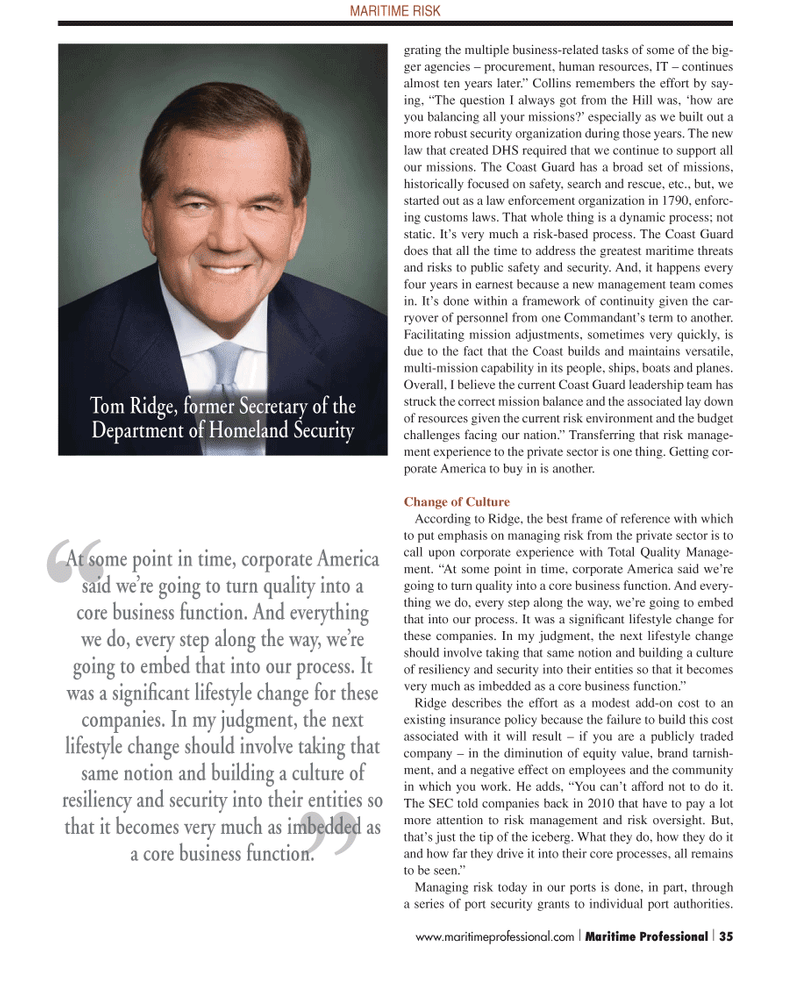
Page 35: of Maritime Logistics Professional Magazine (Q2 2012)
Maritime Risk
Read this page in Pdf, Flash or Html5 edition of Q2 2012 Maritime Logistics Professional Magazine
” “
MARITIME RISK grating the multiple business-related tasks of some of the big- ger agencies – procurement, human resources, IT – continues almost ten years later.” Collins remembers the effort by say- ing, “The question I always got from the Hill was, ‘how are you balancing all your missions?’ especially as we built out a more robust security organization during those years. The new law that created DHS required that we continue to support all our missions. The Coast Guard has a broad set of missions, historically focused on safety, search and rescue, etc., but, we started out as a law enforcement organization in 1790, enforc- ing customs laws. That whole thing is a dynamic process; not static. It’s very much a risk-based process. The Coast Guard does that all the time to address the greatest maritime threats and risks to public safety and security. And, it happens every four years in earnest because a new management team comes in. It’s done within a framework of continuity given the car- ryover of personnel from one Commandant’s term to another.
Facilitating mission adjustments, sometimes very quickly, is due to the fact that the Coast builds and maintains versatile, multi-mission capability in its people, ships, boats and planes.
Overall, I believe the current Coast Guard leadership team has struck the correct mission balance and the associated lay down of resources given the current risk environment and the budget challenges facing our nation.” Transferring that risk manage- ment experience to the private sector is one thing. Getting cor- porate America to buy in is another.
Change of Culture
According to Ridge, the best frame of reference with which to put emphasis on managing risk from the private sector is to call upon corporate experience with Total Quality Manage- ment. “At some point in time, corporate America said we’re going to turn quality into a core business function. And every- thing we do, every step along the way, we’re going to embed that into our process. It was a signifi cant lifestyle change for these companies. In my judgment, the next lifestyle change should involve taking that same notion and building a culture of resiliency and security into their entities so that it becomes very much as imbedded as a core business function.”
Ridge describes the effort as a modest add-on cost to an existing insurance policy because the failure to build this cost associated with it will result – if you are a publicly traded company – in the diminution of equity value, brand tarnish- ment, and a negative effect on employees and the community in which you work. He adds, “You can’t afford not to do it.
The SEC told companies back in 2010 that have to pay a lot more attention to risk management and risk oversight. But, that’s just the tip of the iceberg. What they do, how they do it and how far they drive it into their core processes, all remains to be seen.”
Managing risk today in our ports is done, in part, through a series of port security grants to individual port authorities.
At some point in time, corporate America said we’re going to turn quality into a core business function. And everything we do, every step along the way, we’re going to embed that into our process. It was a signifi cant lifestyle change for these companies. In my judgment, the next lifestyle change should involve taking that same notion and building a culture of resiliency and security into their entities so that it becomes very much as imbedded as a core business function.
Tom Ridge, former Secretary of the
Department of Homeland Security www.maritimeprofessional.com | Maritime Professional | 35
MP #2 34-49 NEW STYLES.indd 35 5/4/2012 5:11:38 PM

 34
34

 36
36
